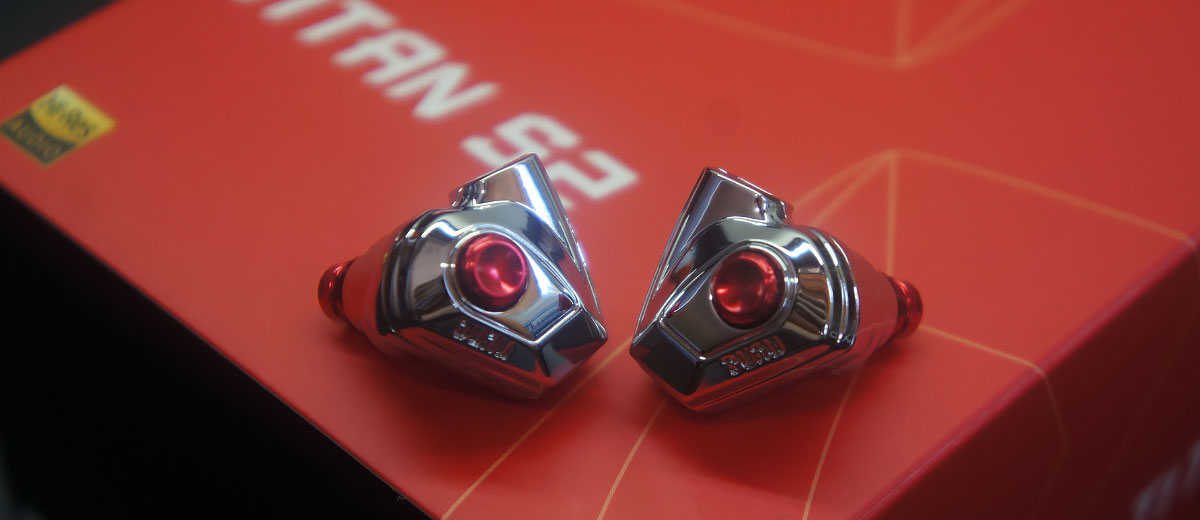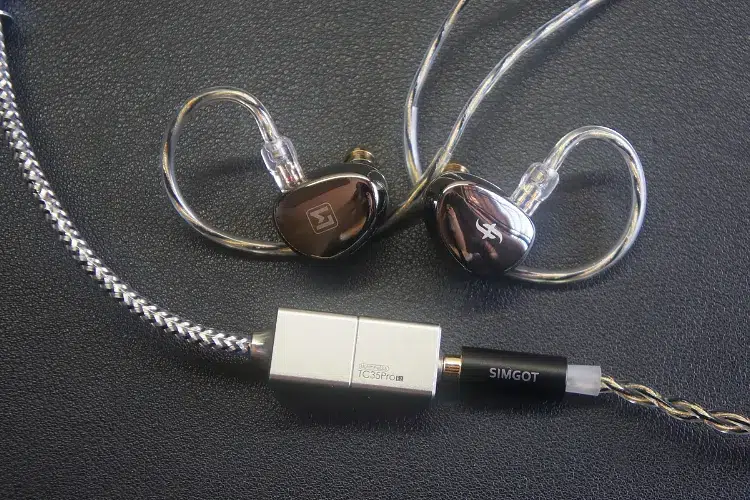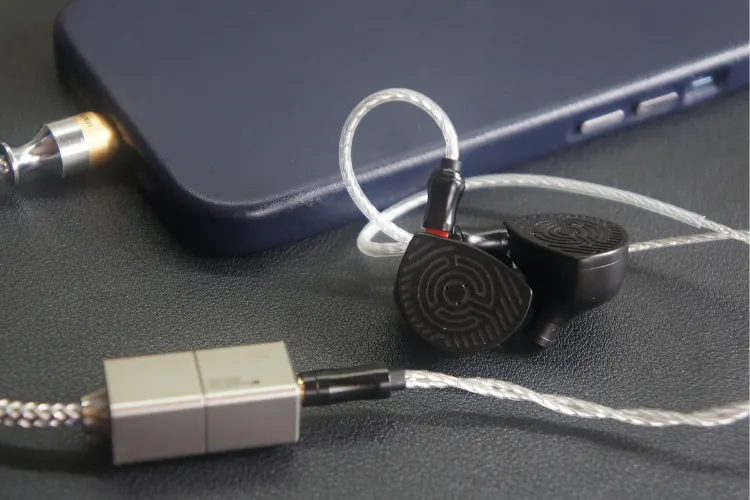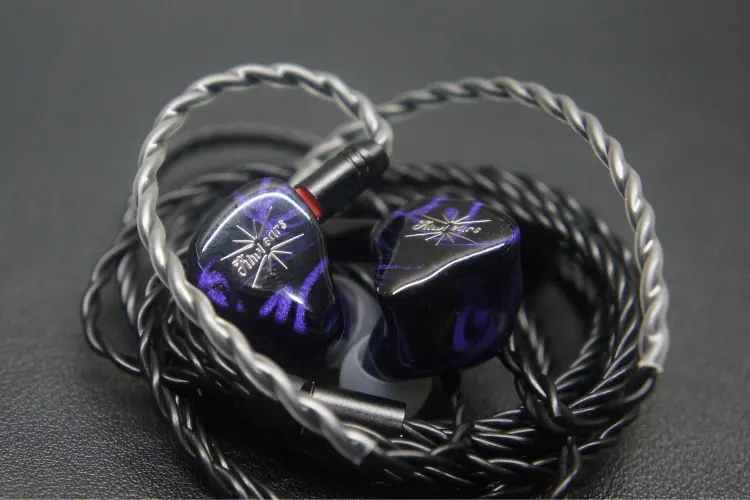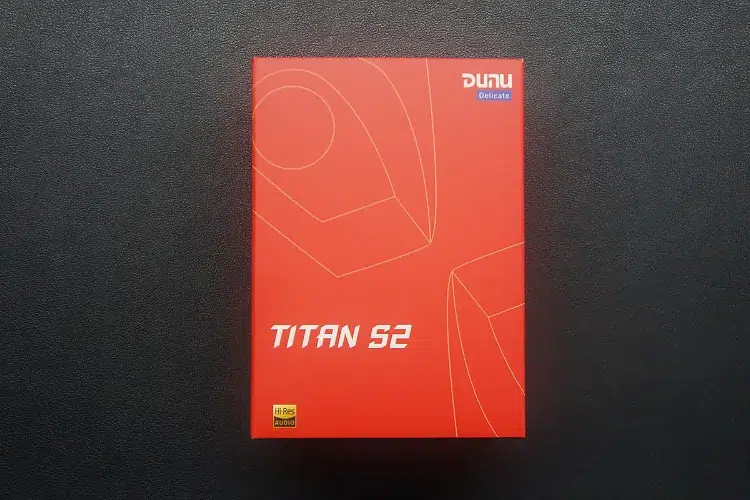Synergy
Efficiency
The Titan S2 has an impedance of 16Ω and a sensitivity of 107 dB/mW, making it easily drivable even when paired with laptops, tablets, DAPs, and smartphones.
However, its bass texture and treble micro-detail performance benefit slightly from a more powerful amplifier or dongle DAC.
During my on-the-go testing with the Titan S2 and its modular Q-lock 3.5mm/4.4mm cable, I paired it with the ddHiFi TC35Pro E2, Letshuoer DT03, and ddHiFi TC44Pro dongle DACs.
For desktop pairings, I connected the Titan S2 to the FiiO K11 desktop DAC/AMP, testing both its single-ended and balanced outputs.
On the K11’s single-ended output, I was able to drive the Titan S2 to a comfortable listening level at around 35% max volume on the high-gain setting. I did not notice any substantial difference between the Titan S2 on the K11’s SE and balanced output.
Pairings
The Titan S2 pairs best with neutral-sounding sources and also does not require much power to maximize. Throughout my testing, I preferred pairing the 7Hz Aurora, (review soon), with the ddHiFi TC35 E2 and the ddHiFi TC44Pro.
With other sources such as the DT03 that have less than ideal mid-range presentation, the Titan’s default lack of mid-range emphasis was just made worse.
The neutral tonality of the ddHiFi TC35 E2 and the ddHiFi TC44Pro maintained the enjoyable U-shaped sound signature of the Titan S2, resulting in a laid-back overall presentation that does not sacrifice too much detail and resolution.
Select Comparisons
Simgot EA500LM
Technical
The SIMGOT EA500LM and the DUNU Titan S2 are single dynamic driver IEMs. The main difference is in the composition of each driver; the EA500LM driver consists of a lithium magnesium dynamic material and the Titan S2 opts for a dual magnet dual chamber driver.
The Titan S2 has an impedance of 16Ω and a sensitivity of 107 dB/mW, while the EA500LM has an impedance of 21Ω and a sensitivity of 107 db/mW. In practice, I found that the Titan S2 was easier to drive.
Design
Both EA500LM and Titan S2 use an all-metal build with a mirror-like finish. The metal on the EA500LM has a darker shade, giving it a more subdued aesthetic, however, both IEMs still have a mirror-like reflectivity.
Surprisingly, I found the EA500LM was much more of a fingerprint magnet. I also found that the Titan’s smaller size and use of ergonomic angles made it more comfortable for use throughout the day, however, I would consider neither uncomfortable.
Performance
The Simgot EA500LM has punchier and deeper bass with a more tactile texture, packing much more power into the sub-bass region than the DUNU Titan S2.
In more complex hip-hop or pop arrangements, the tactility of the EA500LM’s bass makes it a standout, with its deep rhythmic hits serving as the backbone of the entire track.
In comparison, the Titan S2’s sub-bass has a less organic texture; however, the impact of its hits is sufficient to drive the rhythm across a track.
In the bass guitar riffs and low-end synths in funk and disco tracks, the DUNU excels with its gentler bass slope, giving these instruments a warmer velvety tonality that adds a more relaxing sense of atmosphere.
Background synths in disco tracks have more presence on the Simgot EA500LM. The Titan S2 might have even more mid-range presence, but string instruments have better definition and resolution on the Titan S2.
Acoustic string instruments in the mid-range sound more natural and delicately detailed on the DUNU Titan S2. While the DUNU has a more laid-back presentation with a gentle U-shaped tonality, it gives vocals more weight and warmth, except for very high falsetto vocals.
The Simgot EA500LM excels in high-end sparkle and air, sounding more detailed in this region than the Titan S2. The Simgot’s more forward tonality brings out more vocal detail in falsettos and other higher-pitched vocals.
However, the V-shaped sound of the Simgot can make snare drum strikes more fatiguing compared to the Titan S2’s less elevated treble.
Shozy P20
Technical
Inside the DUNU Titan S2 is a dynamic driver, while the Shozy P20 also has a single driver, but instead opts for a 14.5mm planar magnetic driver.
The Titan S2 has an impedance of 16Ω and a sensitivity of 107 dB/mW, while the P20 has an impedance of 30Ω and a sensitivity of 105 dB/mW. In practice, I found the S2 was easier to drive than the P20.
Design
Both the P20 and the Titan S2 use metal shells with the P20 opting for a brushed aluminum construction with a simple circular pattern. This is much more subdued than the chromium-plated alloy shell of the Titan S2 that has a mirror-like finish in most lighting conditions.
In daily use, I found that the P20 was significantly less prone to fingerprints and scratches, and slightly more comfortable in-ear.
Performance
The DUNU Titan S2 has a noticeably beefier and more rounded bass response compared to the Shozy P20. Floor drum hits have an organic texture with better note weight and warmth, making the sound bigger and more impactful.
While both the DUNU Titan S2 and the Shozy P20 have similar sub-bass levels, the DUNU stands out with significantly more mid-bass.
This adds much more texture to the bass tonality, giving percussive hits in the low end a better sense of individuality. Bass riffs, low-end horns, and bass drums on the DUNU Titan S2 are more impactful and textured than on the Shozy P20.
In the mid-range, the Shozy P20 excels with much more detail in mid-range instruments, wind brass instruments, and cymbals. The P20’s detail is outstanding compared to the DUNU Titan S2.
The Titan S2 offers a more satisfying sound for laid-back listening, but the P20 is significantly better for active listening due to its detailed presentation.
Male vocals have more authority and warmth on the DUNU, while female vocals and higher-pitched male vocals are more detailed through the P20.
The DUNU Titan S2 has more high-end elevation, which can make it sound more sibilant compared to the Shozy P20. The P20 achieves even more high-end detail, if not better, than the Titan S2, but it does so without being sibilant or fatiguing. The P20’s sense of microdetail does not depend on elevated volume levels.
It presents mid-range and high-end detail delicately without being overpowering, whereas the DUNU Titan S2 has a warmer, more musical sound.
The P20’s superior microdetail performance effectively separates and positions different chimes and cymbals, especially in jazz tracks, creating a detailed tapestry that elevates the overall listening experience.
Kiwi Ears Quartet
Technical
The Quartet uses dual 10mm dynamic driver and dual balanced armature drivers and has an impedance of 33Ω and a sensitivity of 99 dB. The Titan S2’s impedance of 16Ω and a sensitivity of 107 dB was slightly easier to drive than the Quartet in practice.
Design
The Quartet uses the more common Chi-Fi shell, opting for a 3D-printed resin shell with black and purple swirls. Compared to the Titan S2 and its chromium-plated alloy shell, the Quartet is significantly lighter and less prone to daily wear and tear.
In my testing, I found the Quartet and its lighter construction to be substantially more comfortable than the Titan S2, but I had no problem with using either IEM for hours at a time.
Performance
The Quartet has more mid-bass bloat, which causes the bass to bleed into the mid-range, muddying the detail retrieval and articulation of lower mid-range instruments, and affecting even string instruments.
Its warmth and mid-bass emphasis create a more impactful sound signature that suits atmospheric synths and bass lines but significantly sacrifices detail and resolution.
Individual hits from kick drums have a punchier impact on the Quartet, however, the Titan S2 has a more textured presentation, whose more subtle approach to fidelity does a better job of complementing the other instruments in the mix.
The DUNU Titan S2 outperforms the Quartet in mid-range technicalities and tonalities. String instruments lose their delicate detail on the Quartet compared to the Titan S2.
The Titan S2 outclasses the mid-range performance of the Quartet both in quantity and quality. String instruments lose their delicate detail on the Quartet compared to the Titan S2. Individual strums and all their nuance get muffled out by the overly warm bloat that bleeds into the mid-range.
In comparison, the Titan S2 can preserve the detail in these instruments and maintain a musical presentation despite their lack of emphasis and note weight
The Titan S2 is much more detailed in the high-end frequencies than the Quartet. Highs are crispier and more defined on the Titan S2.
It excels at differentiating high-end chimes, cymbals, and steel instruments, whereas the Quartet delivers them in a blunted and lifeless manner. The Quartet’s overly warm tonality sometimes muffles these high-end sounds.
My Verdict
I would describe the DUNU Titan S2 as a value-king at the sub-$100 price point with its excellent modular cable, and its inclusion of 4 ear tips, 2 of which are worth $25 on their own.
The IEMs have a gently U-shaped sound signature that integrates more warmth and high-end fidelity compared to the “exciting” sounding V-shaped competition.
Compared to other IEMs, some listeners may find the Titan S2 lacking mid-range dynamics.
However, with relaxed tonality, decent resolution performance, and excellent package inclusions, the Titan S2 is a good addition to any collection, even for its accessories alone.
DUNU Titan S2 Technical Specifications
- Driver configuration: Single Dynamic Driver
- Frequency response: 5 Hz – 40 kHz.
- Impedance: 16Ω at 1 kHz.
- Sensitivity: 107 dB/mW (@1 kHz), 125 dB/Vrms (@1 kHz).
- Connector: 2-pin 0.78mm.
- 3.5mm single-ended and 4.4mm balanced interchangeable plugs.

